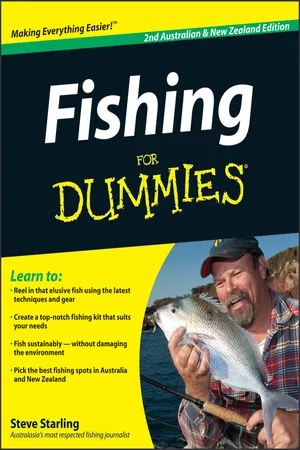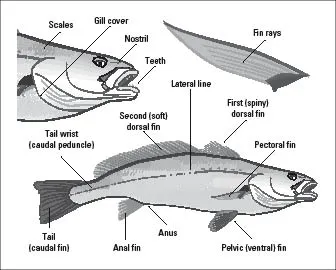Part I
Getting to Know Fish
Glenn Lumsden
‘Apparently I have firm, white, fine-grained flesh and I’m high in Omega-3 fatty acids. No wonder I’m such a catch!’
In this part . . .
The most important ingredient in the fishing equation is the fish themselves. Chapter 1 gives you a vital overview of the anatomy of fish and how fish live — and survive — and the chapter offers a range of important insights into the recreational angling process. Chapter 2 and Chapter 3 describe, in detail, Australia and New Zealand’s most popular saltwater and freshwater fish, where to find these fish, how to catch the critters and whether or not the fish listed make tasty treats.
Chapter 1
Fishing Fundamentals
In This Chapter
Understanding how fish work
Deciding what type of angler you are
Making the hunt as hard (or easy) as you want
The delightful recreation we call fishing has many facets and in this book I’m taking on the challenge of attempting to explain all of them. First up, is the subject I regard as the single most important ingredient — the fish!
‘How-to’ texts on angling often bury the chapters that actually talk about fish way back in the book or they place information about this vital ingredient at the end. I can state this with authority because I’ve buried the poor old fish at the deep end of books myself, when in truth the act of fishing is a pointless exercise without these wonderful creatures. Fish deserve prominence and respect and that’s why I’m dealing with fish up front.
Every other subject in this book is guided, shaped and dictated by fish and their behaviour, so it makes perfect sense to deal with these champions of evolution before any other subject. On the off-chance that you disagree with this approach and are eager to dive straight into the chapters covering fishing gear and techniques, by all means skip this section for now, but please do come back for a visit later.
Defining Fish
According to The Macquarie Dictionary, a fish is ‘. . . any of various cold-blooded, completely aquatic vertebrates, having gills, fins and typically an elongated body, usually covered with scales . . .’ While numerous exceptions to this simple definition exist — including a few fish with warm blood and others without scales or obvious fins — this definition is just fine for understanding the basics of the type of fish you’re likely to catch for the pan.
In fact, I believe recognising a true fish from one of the many critters that are commonly but incorrectly called fish (see Figure 1-1) is more important. Dolphins, porpoises, whales, dugongs and many other aquatic mammals are definitely not fish. Neither are sharks, stingrays and skate, which have a type of skeleton made from cartilage (tough, fibrous tissue) rather than bone.
For this reason, these types of marine life are sometimes referred to as cartilaginous fish, as different from bony or ‘true’ fish . . . Whoops! I’m becoming a little bogged down in the scientific stuff — sorry. How about I promise not to tell you off if you call a shark a fish, if you promise to put up with my occasional bits of technical ranting?
Fish galore
More than 2,000 different kinds of fish swim in the salty ocean waters around Australia and New Zealand, and a couple of hundred more in our rivers and lakes, but only a small percentage of these are of real interest to anglers. The majority of fish are either too small or live in unreachable depths. Fortunately, that leaves plenty of fascinating targets to pursue — more than enough to fill a long and interesting lifetime of angling. (I look at favourite saltwater fish in Chapter 2 and favourite freshwater fish in Chapter 3.)
In Chapters 2 and 3, I examine 16 of the most popular and sought-after Australian and New Zealand fish — ten from salt water and six from fresh. While you may well end up pursuing and catching fish not included in these chapters, a basic knowledge of these 16 common, widely distributed species provides an excellent basis to work from.
Fish wishes
Fish have simple needs and their lives appear to be dominated by three driving forces: the quest for food, the desire not to be eaten and the urge to reproduce. Eat, run away and have sex. What’s simpler than that?
As an angler, the more you know about these three primary motivating forces, the better your chances of finding and catching fish.
A fish-eat-fish world
The vast majority of fish species eat other fish — at least some of the time. Even the so-called vegetarian types (such as mullet, carp and luderick) aren’t above snacking on hapless small fry from time to time.
In addition to eating smaller fish (sometimes not that much smaller!), most fish dine regularly on other aquatic critters such as shrimps, prawns, crabs, marine worms, shellfish, squid, octopus and various forms of plankton. Freshwater fish and a number of saltwater fish also regularly snack on land-dwelling organisms such as insects, spiders, grubs, earthworms and even small birds and mammals unlucky enough to drop in for dinner. Several types of fish are also partial to feeding on the amphibians and reptiles — particularly frogs, lizards, snakes and baby turtles — that share their watery habitat.
Add to this a penchant for munching on dead and decaying animal or vegetable matter and scavenging for human detritus — including everything from discarded lunch scraps to the nastier items that pour out of stormwater drains and sewage pipes — and you come up with an extr...


